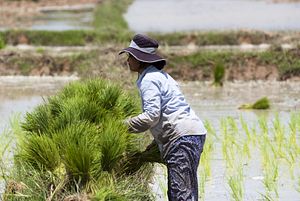Like many in Southeast Asia, Cambodians can be a superstitious lot and each year they take their cue from a yoke of royal oxen, whose choice of cuisine will signal what to expect in the year ahead for this occasionally troubled country.
Presided over by King Norodom Sihamoni and the palace’s chief astrologer Kang Ken at a local football field, the elaborately dressed oxen undertook a symbolic ploughing of the field before being led to seven bowls of corn, beans, rice, sesame, freshly cut grass, water and rice wine where they were encouraged to graze.
Gorging on corn, beans and rice – the more the better – are portents of a bountiful harvest. A preference for grass indicates sickness, water represents floods, and alcohol is an omen of war.
It’s an ancient ritual timed as the planting season gets underway, ahead of the annual rains. This year three pairs of oxen headed straight for the corn and beans, which indicates a terrific harvest for both, but all others, including the all-important rice, were ignored.
That led to a sense of dismay among superstitious farmers, keen to get a foothold into Cambodia’s booming rice industry, who had gathered in the northwest province of Battambang.
Complaints from one aging farmer were typical of the older generation, saying that a shortage of rice, the national staple, was a bad sign for this year’s crop.
“I don’t like this at all, not at all,” he said. “We don’t want to go hungry, nobody wants to go hungry.”
Kang Ken attempted to assuage the thousands in attendance and many more watching on television screens around the country that this ceremony was more about respect for annual traditions, which were wiped out by the decades of war.
“This is just a prediction based on the custom of the royal ploughing ceremony in the old era,” Kang Ken said. “This ceremony is to notify the farmers that agricultural season has come.”
According to the Ministry of Agriculture, Cambodia is an agrarian country with about 80 percent of the population eking out a living as farmers which accounted for 28.7 percent of the country’s gross domestic product in 2014.
Modern milling systems adopted by farmers in recent years have helped bolster Cambodian rice in the international market.
In 2009, Cambodia exported just 12,613 tons of milled rice. Since then, the country has become the world’s fifth-largest exporter of rice and the second-biggest exporter of premium jasmine rice with sales of milled rice abroad in 2013 reaching 378,856 tons.
There are plans to raise this to one million tons.
Still the government often complains that old habits die hard with about 40 percent of Cambodia’s nine million farmers incapable of producing rice of a suitable quality for export.
Those habits are given a full airing at the annual ploughing ceremony which has also proven controversial since it was reintroduced in 1994 after a 25-year absence due to war.
Observers have noted there is a tendency by farmers to plant what the bovine oracles tuck into, leading to self-fulfilling prophecies. In 2009, when the full impact of the Global Financial Crisis was biting, the royal oxen chose only corn which was interpreted as an astute sign of the times.
Last year, the oxen doubled-down on corn, beans, sesame and rice, correctly indicating a bumper harvest was in the offing.
But in 2001, Prime Minister Hun Sen chided royal astrologers after they failed to predict severe floods in Cambodia, which left 59 people dead. Those floods followed what was believed to be a record year for flooding in 2000 which claimed 347 lives and caused $145 million in damages.
Luke Hunt can be followed on Twitter @lukeanthonyhunt

































